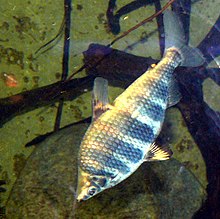Anostomidae
| Anostomidae | |
|---|---|
 |
|
|
Abramites hypselonotus in headstander swimming pose |
|
| Scientific classification | |
| Kingdom: | Animalia |
| Phylum: | Chordata |
| Superclass: | Osteichthyes |
| Class: | Actinopterygii |
| Subclass: | Neopterygii |
| Infraclass: | Teleostei |
| Superorder: | Ostariophysi |
| Order: | Characiformes |
| Superfamily: | Anostomoidea |
| Family: |
Anostomidae Günther, 1864 |
| Genera | |
|
Presently 14, but see text |
|
| Synonyms | |
|
Anostomina Günther, 1864 |
|
Presently 14, but see text
Anostomina Günther, 1864
Anostominae (sensu Boulenger, 1904 et al.)
The Anostomidae are a family of ray-finned fishes that belong to the order Characiformes. Closely related to the Chilodontidae and formerly included with them, the Anostomidae contain about 150 described species. Commonly known as anostomids, they are found in freshwater habitats from the Río Atrato in northernmost South America to warm-temperate central Argentina; they are of Amazon origin, with few found west of the Andes (mainly in Colombia and Venezuela). Their scientific name approximately means "mouth on top", from Ancient Greek áno- (ἄνω) "up" (as an adverb) + stóma (στόμᾶ) "mouth", in reference to the arrangement of these fishes' mouth opening.
Anostomids have elongated bodies ranging from 15 to 60 cm (5.9 to 23.6 in) in length; their shape varies between and deeper-bodied, but even the latter are only moderately laterally. They have elongated, tapering heads with rather long, straight snouts, and small apical to upturned mouths immediately at or near the snout tip. This family contains many headstanders, which habitually swim with their heads pointing from 45° up to 90° downwards; most feed on plants near the bottom, while others also eat detritus and invertebrates picked up from river- or lakebeds. Adults guard the eggs after spawning. Anostomidae are generally considered edible, and some of the larger species are caught for food on a regular basis, much like large Leuciscinae (which are superficially similar Cypriniformes) are in the temperate Northern Hemisphere.
...
Wikipedia
